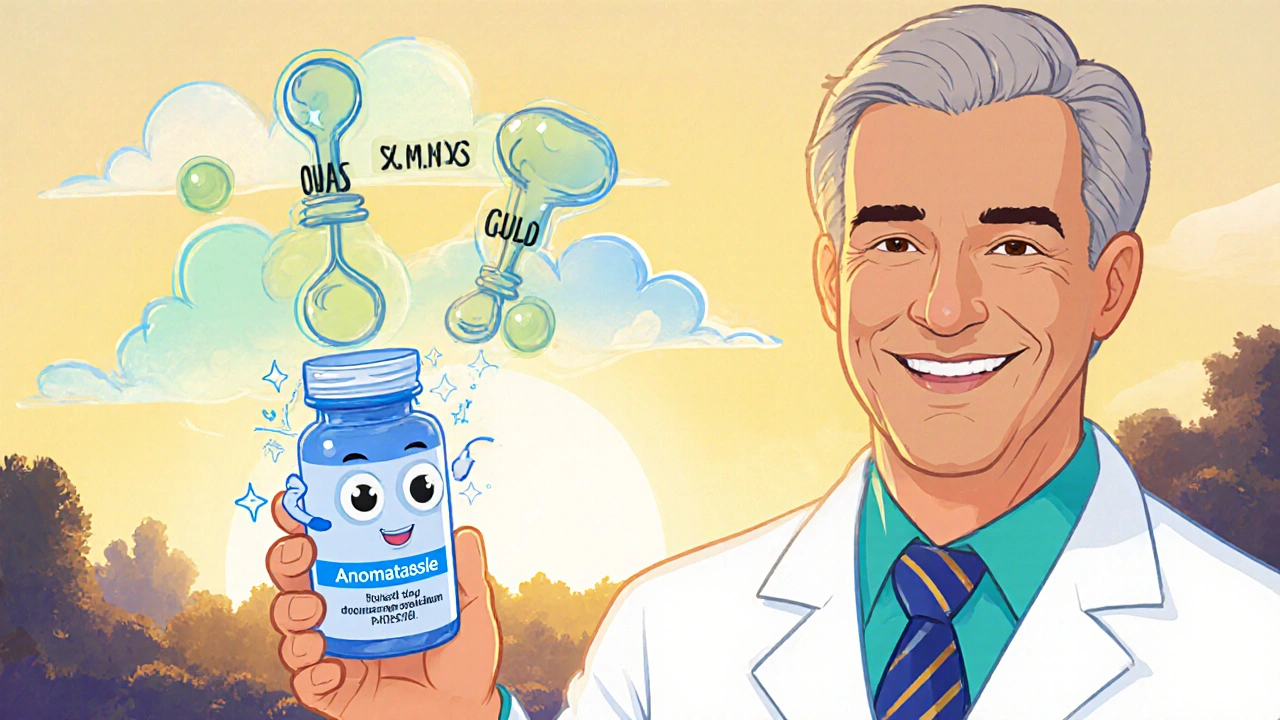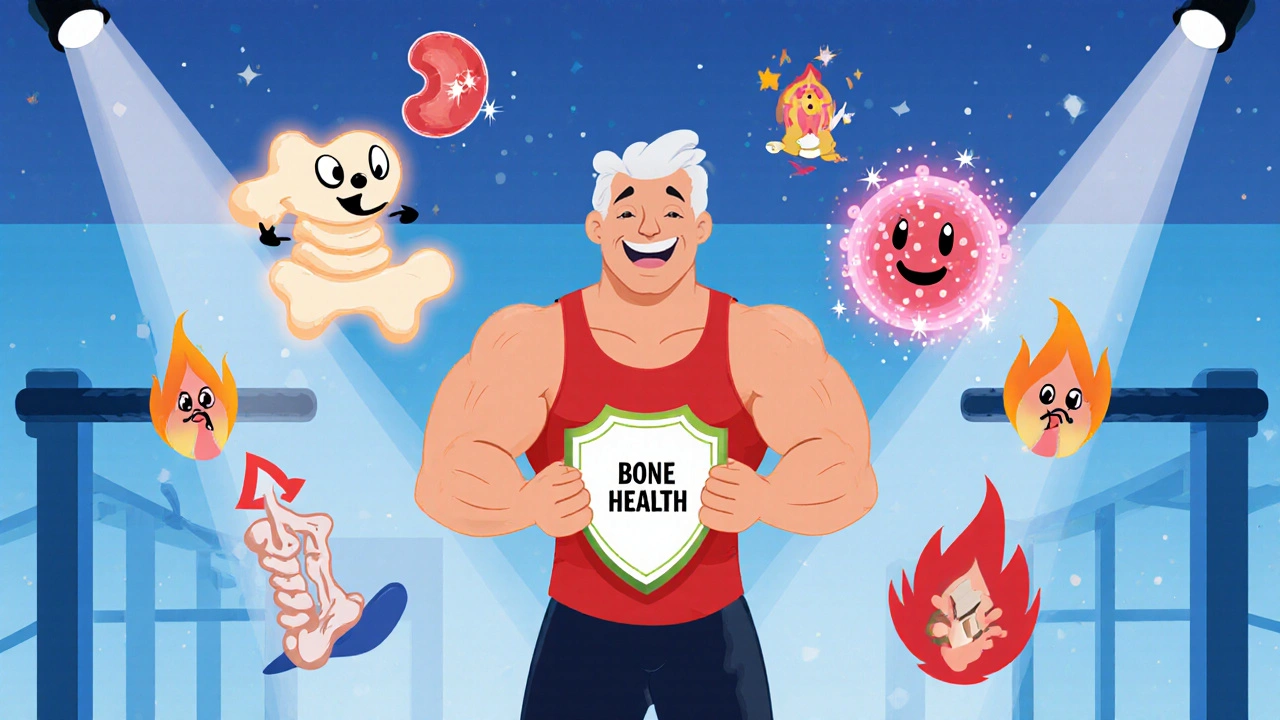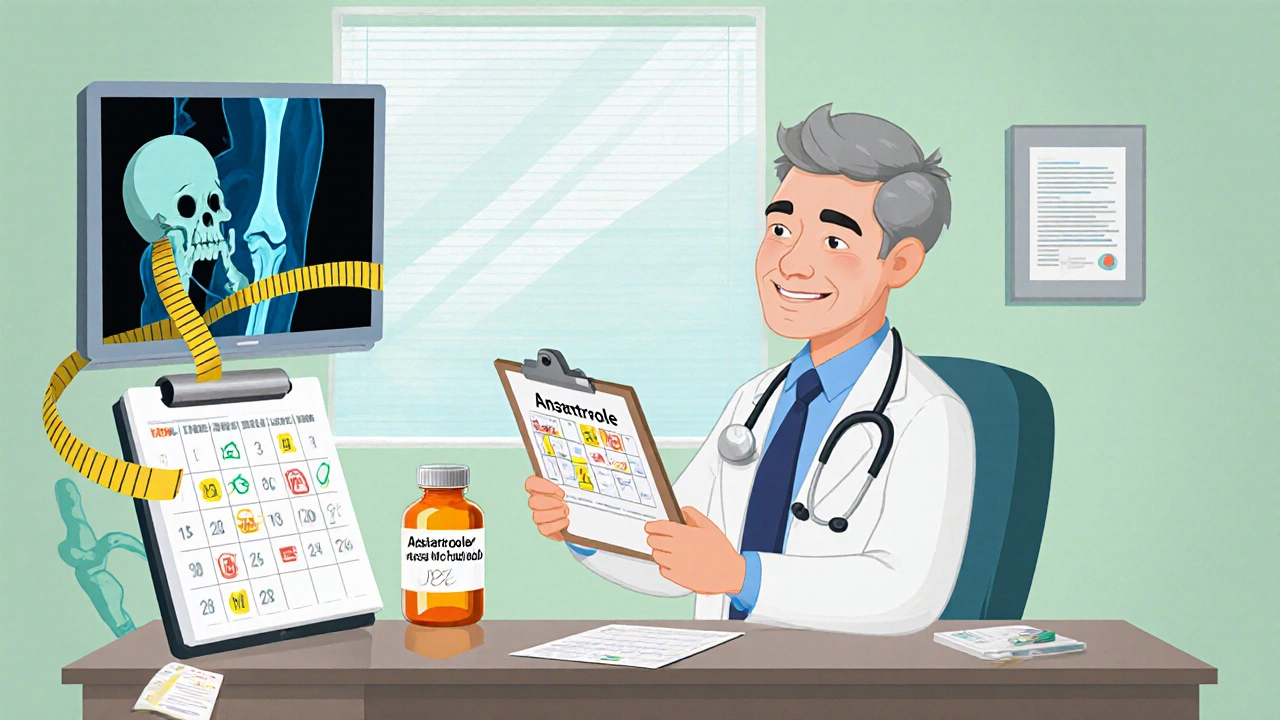Anastrozole and Aging: A Complete Guide for 2025

Aromatase Inhibitor Comparison Tool
Compare Aromatase Inhibitors for Aging
Select the factors most important to you to determine which aromatase inhibitor might be best suited for your situation based on clinical evidence.
What are your top priorities?
Anastrozole is a potent aromatase inhibitor that blocks the enzyme aromatase, reducing the conversion of testosterone into estrogen. Originally approved for post‑menopausal breast cancer, it’s increasingly discussed in the context of aging because lower estrogen levels can influence muscle mass, bone health, and metabolic profile. This guide walks you through how Anastrozole works, why some clinicians consider it for age‑related hormone balance, what the evidence says, and how to manage the risks.
Key Takeaways
- Anastrozole lowers estrogen by inhibiting aromatase, which can affect bone density and cholesterol.
- Off‑label use for men over 50 targets excess estrogen that may blunt testosterone benefits.
- Common side effects include joint pain, hot flashes, and mild fatigue; serious risks involve bone loss and cardiovascular changes.
- Regular monitoring of bone density, lipid profile, and hormone levels is essential.
- Alternatives such as letrozole and exemestane have slightly different safety profiles.
What is Anastrozole?
As a aromatase inhibitor, Anastrozole blocks the enzyme aromatase, which normally converts testosterone into estrogen. By reducing estrogen levels, the drug can slow the growth of estrogen‑dependent breast tumors. The standard dose for cancer is 1 mg daily, but dosing for anti‑aging purposes often ranges from 0.25 mg to 0.5 mg, sometimes taken every other day to avoid overt estrogen suppression.
Why Aging Matters: Hormone Shifts in Mid‑Life
Aging is not just about wrinkles; it’s a hormonal transition. In men, testosterone gradually declines after age 30, while estrogen (produced via aromatization) may stay relatively steady or even rise, leading to a higher estrogen‑to‑testosterone ratio. Elevated estrogen can blunt the anabolic effects of testosterone, contribute to gynecomastia, and affect mood. Some clinicians therefore prescribe low‑dose Anastrozole to rebalance this ratio, hoping to preserve lean mass, improve insulin sensitivity, and maintain bone health.
Potential Benefits of Low‑Dose Anastrozole in Older Adults
Clinical observations and a handful of small trials suggest the following benefits when used responsibly:
- Muscle preservation: Lower estrogen may allow testosterone‑driven protein synthesis to work more efficiently.
- Bone health nuance: While estrogen protects bone, modest reduction can stimulate bone remodeling, potentially improving bone quality if combined with resistance training and adequate calcium/vitamin D.
- Metabolic improvements: Some men report better lipid profiles and reduced visceral fat.
- Reduced gynecomastia risk: Lower estrogen levels can prevent breast tissue growth.
It’s important to stress that these outcomes are not guaranteed; robust, large‑scale trials are still lacking as of 2025.

Risks and Side Effects to Watch
Even at low doses, Anastrozole can cause side effects. The most common include:
- Joint and muscle aches (often called “arthralgia”).
- Hot flashes and night sweats.
- Mild fatigue or mood changes.
More serious concerns arise with prolonged use:
- Bone density loss - estrogen is a key protector of bone, so excessive suppression can raise fracture risk.
- Changes in cholesterol - HDL may drop while LDL rises in some users.
- Potential cardiovascular effects - data are mixed, but monitoring blood pressure and lipid panels is recommended.
Women, especially post‑menopausal, should avoid off‑label Anastrozole unless under strict medical supervision because further estrogen reduction can accelerate osteoporosis.
Dosage, Monitoring, and Safety Guidelines
When considering Anastrozole for age‑related hormone balance, follow these practical steps:
- Start with 0.25 mg every other day; some clinicians prefer 0.5 mg once weekly.
- Measure baseline testosterone, estrogen, lipid profile, and bone density (DEXA scan).
- Re‑check labs after 6-8 weeks; adjust dose to keep estradiol in the low‑normal male range (10-30 pg/mL).
- Continue annual DEXA scans; if bone loss exceeds 2 % per year, consider calcium 1000 mg, vitamin D 800 IU, and possibly a bisphosphonate.
- Track symptoms daily; stop the drug if joint pain becomes limiting or if any cardiovascular event occurs.
How Anastrozole Stacks with Other Hormone Strategies
Many men combine Anastrozole with testosterone replacement therapy (TRT). The typical protocol is:
- Start TRT (e.g., 100 mg testosterone enanthate weekly) and let levels stabilize for 4 weeks.
- Introduce low‑dose Anastrozole if estradiol rises above target.
Other supplements-zinc, magnesium, and omega‑3 fatty acids-can support hormone balance and mitigate side effects. However, never self‑prescribe; a qualified endocrinologist or anti‑aging specialist should guide the regimen.

Comparison with Other Aromatase Inhibitors
| Attribute | Anastrozole | Letrozole | Exemestane |
|---|---|---|---|
| Typical cancer dose | 1 mg daily | 2.5 mg daily | 25 mg daily |
| Off‑label low dose for men | 0.25-0.5 mg 2-3 × week | 0.5-1 mg 2-3 × week | 5-10 mg 2-3 × week |
| Half‑life | ~50 hours | ~2 days | ~24 hours |
| Bone safety (low dose) | Moderate - monitor | Higher risk of loss | Least impact on bone |
| Common side effects | Joint pain, hot flashes | Fatigue, nausea | Muscle aches, mild liver enzyme rise |
| Cost (US, 2025) | $0.30 / pill | $0.45 / pill | $0.55 / pill |
For most aging men, Anastrozole offers a balanced mix of potency and tolerability. Letrozole can be stronger but may carry higher bone‑loss risk; Exemestane is steroidal, often gentler on bone but less studied for anti‑aging.
Practical Checklist Before Starting
- Confirm baseline labs: testosterone, estradiol, lipid panel, DEXA.
- Discuss any history of osteoporosis, cardiovascular disease, or liver issues with your doctor.
- Set a clear dosing schedule and a reminder system.
- Plan follow‑up labs at 6‑weeks, 3‑months, then annually.
- Have a backup plan if side effects emerge (dose reduction or switch to exemestane).
Frequently Asked Questions
Can women use Anastrozole for anti‑aging?
Off‑label use in post‑menopausal women is generally discouraged because estrogen protects bone and cardiovascular health. Any use should only be under specialist supervision and paired with aggressive bone‑protective strategies.
How quickly does Anastrozole lower estrogen?
Serum estradiol drops about 30‑40 % within 48 hours of a 1 mg dose. Low‑dose regimens produce a gentler decline, usually reaching a new steady state in 1-2 weeks.
Will Anastrozole affect libido?
Many men report a modest libido boost when estradiol falls into the low‑normal range, especially if they’re also on testosterone. However, too low estrogen can lead to joint pain and mood swings that may dampen desire.
Is it safe to combine Anastrozole with statins?
There’s no direct drug‑drug interaction, but both can affect liver enzymes. Periodic liver function tests are prudent when the two are taken together.
What’s the best way to track bone health while on Anastrozole?
Start with a baseline DEXA scan, repeat every 12‑18 months, and keep calcium intake ≥ 1,000 mg/day plus vitamin D ≥ 800 IU/day. If bone loss exceeds 2 % per year, discuss adding a bisphosphonate or switching to exemestane.
In summary, Anastrozole can be a useful tool for managing hormonal shifts that accompany aging, but it demands careful dosing, regular monitoring, and a clear understanding of risks. Pairing the drug with lifestyle measures-strength training, balanced nutrition, and regular health checks-offers the safest path to any potential benefits.

Anastrozole works by binding to the aromatase enzyme, thereby preventing the conversion of testosterone into estradiol, which in turn can shift the hormonal milieu in aging men. By lowering circulating estrogen, it may unmask the anabolic potential of testosterone, allowing for greater protein synthesis during resistance training. However, estrogen also plays a protective role in bone remodeling, so chronic suppression without adequate calcium and vitamin D can accelerate osteoclastic activity. Clinical monitoring should therefore include baseline DEXA scans, as well as periodic repeats every 12 to 18 months to catch early bone loss. Lipid panels are another essential component, because estradiol influences HDL synthesis and LDL clearance, and reductions can manifest as a modest rise in LDL cholesterol. In practice, starting doses of 0.25 mg every other day have been shown to modestly lower estradiol without plunging levels into the hypo‑estrogenic range. Patients who experience joint discomfort often benefit from alternating the dosing schedule to a 0.5 mg weekly regimen, which smooths plasma concentrations. It is crucial to obtain serum estradiol measurements six to eight weeks after initiation, aiming for a low‑normal male range of roughly 10‑30 pg/mL. If levels drop below 10 pg/mL, symptoms such as mood swings, reduced libido, and bone pain may emerge, indicating overt suppression. Conversely, if estradiol remains above 30 pg/mL, the anticipated benefits on muscle preservation may be blunted, prompting a modest dose increase. Nutrition also plays a supportive role; adequate protein intake, omega‑3 fatty acids, and micronutrients like zinc can amplify the hormonal benefits. Exercise remains the cornerstone, with resistance training providing mechanical stimulus that synergizes with the altered hormonal environment. For men on concurrent testosterone replacement therapy, the interplay can be complex, as exogenous testosterone can elevate aromatization rates, necessitating periodic Anastrozole adjustments. Importantly, patients with a history of cardiovascular disease should be counseled about potential lipid shifts and have their blood pressure monitored regularly. In summary, a judicious, low‑dose Anastrozole protocol, combined with lifestyle optimization and vigilant laboratory surveillance, offers a balanced approach to mitigating age‑related hormonal drift.
Hormonal balance is a subtle dance. Aging shifts the rhythm, and we must listen to what the body tells us. Keeping labs in check while staying active can make the transition smoother.
Sure, take a cheap cancer drug to feel younger, because that's exactly what responsible men do. If you trust a pink pill more than common sense, you're already lost.
Did you kno they’re pushin’ these aromatase inhibitors to keep us dependent on big pharma? The “studies” are all funded by the same guys that sell us the needles. It’s like they want us all on some hormone cocktail while they cash in. Stay woke, question every “expert”.
Monitoring is the backbone of any anti‑aging protocol. Start with a solid baseline: testosterone, estradiol, lipids, and a DEXA scan. Re‑check labs at 6‑8 weeks and adjust the dose to stay in the low‑normal estradiol range. Pair the medication with strength training and adequate nutrition for optimal results.
Adding a weekly vitamin D3 supplement of 2,000 IU can further protect bone density while on Anastrozole. It’s also wise to schedule a follow‑up visit with an endocrinologist to interpret the hormonal trends. Consistency in timing the dose each day helps maintain steady serum levels.
The pharmacokinetic profile of Anastrozole, characterized by a ~50‑hour half‑life, permits once‑daily dosing but also necessitates careful titration in geriatric cohorts. Enzymatic inhibition follows a reversible, competitive mechanism, thereby preserving peripheral aromatase activity at sub‑therapeutic concentrations. Consequently, the drug exhibits a dose‑response curve that plateaus beyond 0.5 mg, mitigating incremental benefits while amplifying adverse events such as dyslipidemia. Incorporating a Bayesian adaptive monitoring framework can optimize individualized dosing regimens.
🤔 It’s natural to feel uneasy when information feels one‑sided, but balanced research helps cut through the noise.
Think of Anastrozole as a dimmer switch on a stage light; you’re not turning the lights off completely, just lowering the glare so the spotlight on muscle can shine brighter. When the estrogen flood recedes, testosterone gets the stage to its full potential, but you still need a solid set‑piece of weight training to keep the show running. The drug alone won’t sculpt a physique; it merely removes the fog that can obscure progress. Pair it with a protein‑rich diet, and you’ll see the gains emerge like sunrise over a calm sea.
That analogy captures the concept nicely; keeping the basics solid is key.
Honestly the drug is overhyped, most peopel dont need it at all.
Stay healthy, stay happy 😊
Totally agree, lol keep those good vibes comin!
Anastrozole can aid hormone balance in aging men when dosed low, monitored closely, and combined with lifestyle measures.
Sounds solid! 🚀 Just remember the labs and keep moving forward, you got this!